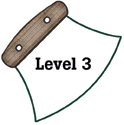
Alaska Science
Key Element A10
A student who meets the content standard should understand that living things are made up mostly of cells and that all life processes occur in cells (Cells).
 |
Alaska Science A student who meets the content standard should understand that living things are made up mostly of cells and that all life processes occur in cells (Cells). |
|
Performance Standard Level 3, Ages 11–14
|
|
|
|
Sample Assessment Ideas
|
Standards Cross-References
|
||
|
National Science Education Standards Cells carry on the many functions needed to sustain life. They grow and divide, thereby producing more cells. This requires that they take in nutrients, which they use to provide energy for the work that cells do and to make the materials that a cell or an organism needs. (Page 156) Specialized cells perform specialized functions in multicellular organisms. Groups of specialized cells cooperate to form a tissue, such as a muscle. Different tissues are in turn grouped together to form larger functional units, called organs. Each type of cell, tissue, and organ has a distinct structure and set of functions that serve the organism as a whole. (Page 156) |
Benchmarks All living things are composed of cells, from just one to many millions, whose details usually are visible only through a microscope. Different body tissues and organs are made up of different kinds of cells. The cells in similar tissues and organs in other animals are similar to those in human beings but differ somewhat from cells found in plants. (Page 112) Cells repeatedly divide to make more cells for growth and repair. Various organs and tissues function to serve the needs of cells for food, air, and waste removal. (Page 112) Within cells, many of the basic functions of organisms—such as extracting energy from food and getting rid of waste—are carried out. The way in which cells function is similar in all living organisms. (Page 112) About two-thirds of the weight of cells is accounted for by water, which gives cells many of their properties. (Page 112) |
|
Table of Contents | Return to Alaska Native Knowledge Network